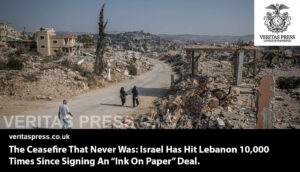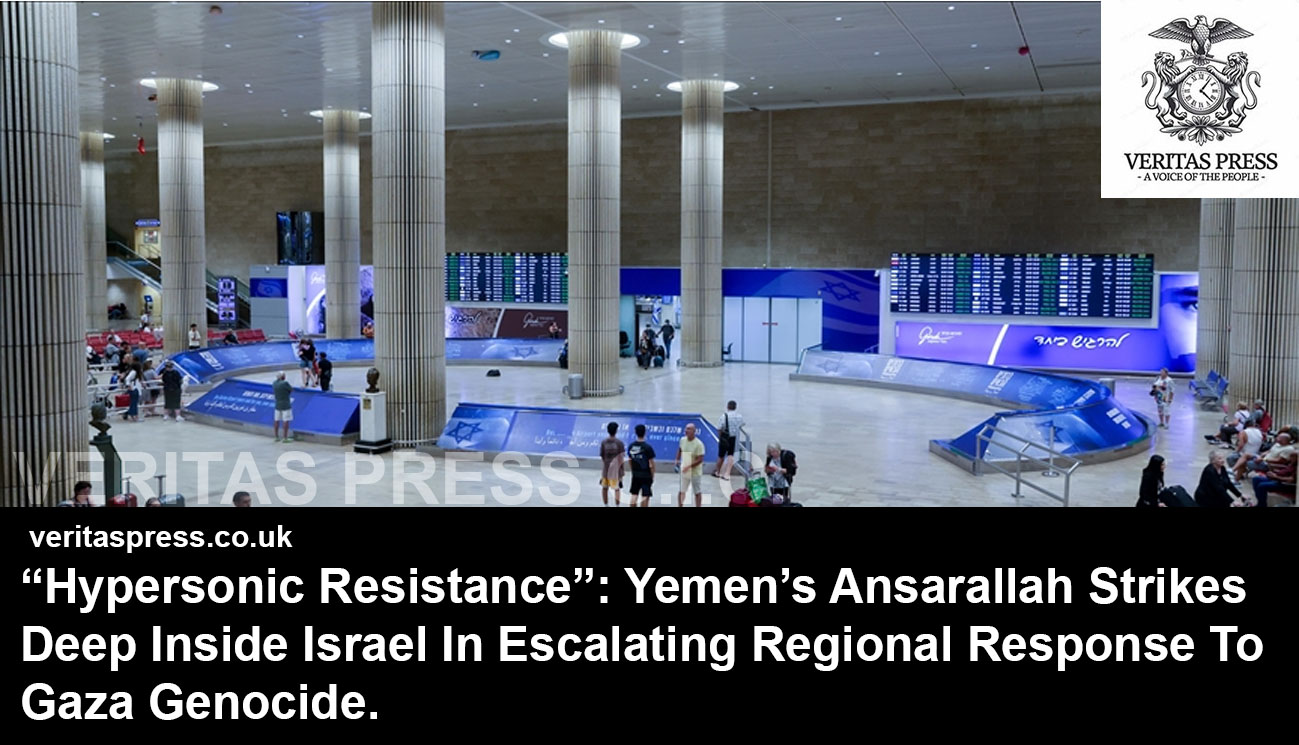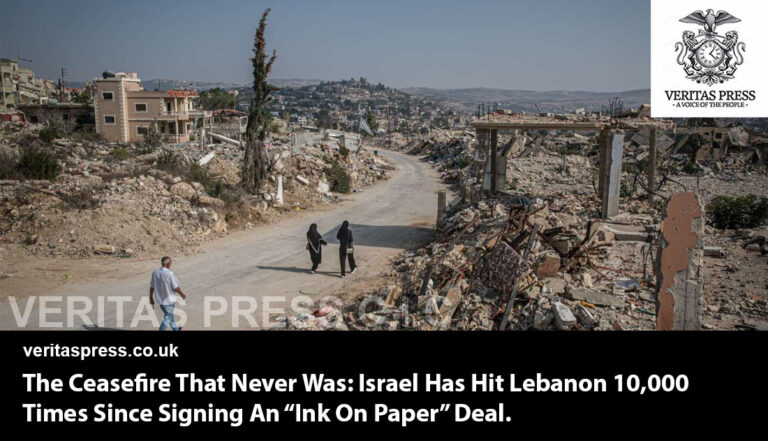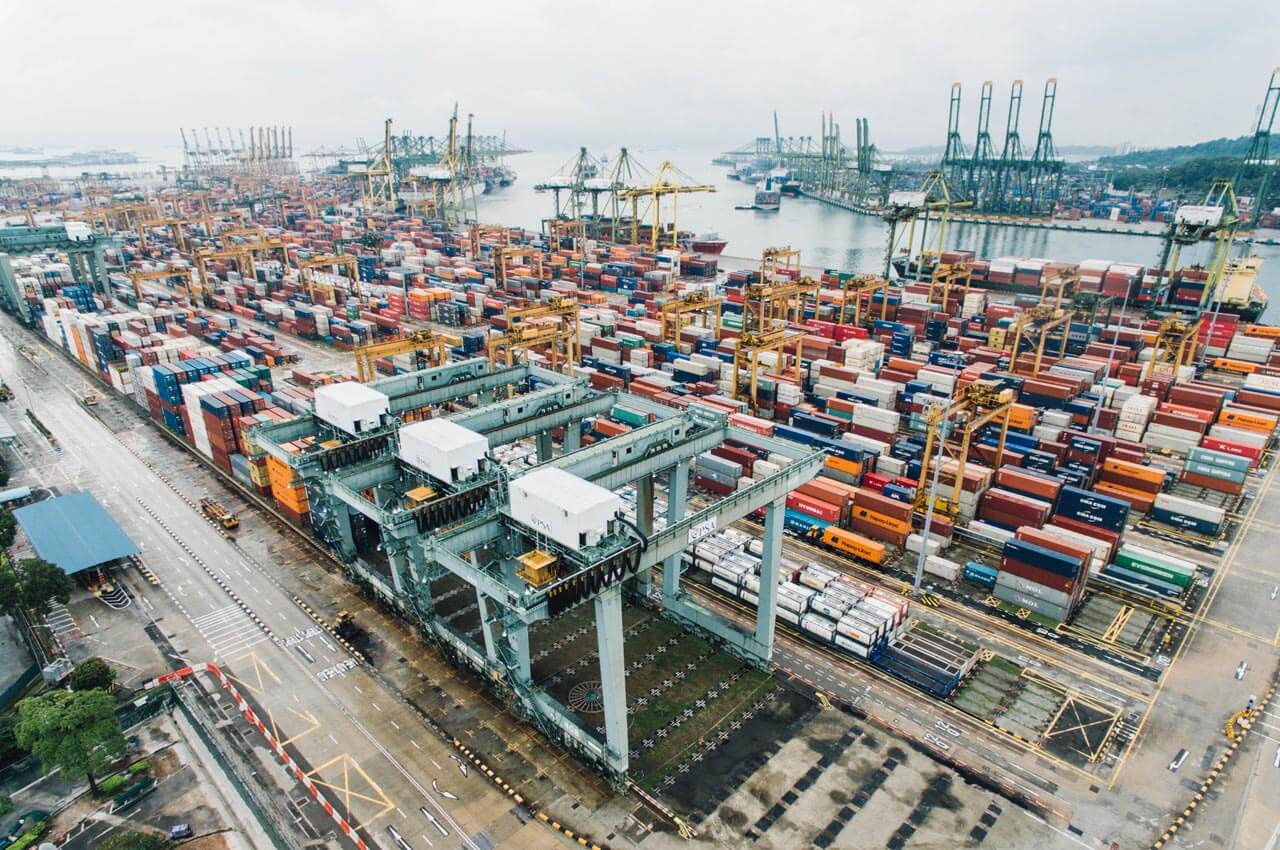Press Release: Veritas Press C.I.C.
Author: Kamran Faqir
Article Date Published: 05 Aug 2025 at 16:17 GMT
Category: Middle East | Yemen |
Source(s): Veritas Press C.I.C. | Multi News Agencies
TEL AVIV / SANAA — In a development that has sent ripples across military and diplomatic establishments in the Middle East, Yemen’s Ansarallah movement (commonly known as the Houthis) has claimed responsibility for launching a hypersonic ballistic missile at Israel’s Ben Gurion Airport in Tel Aviv, marking the deepest and most symbolic direct strike yet in a widening regional campaign of military solidarity with Gaza.
Israeli officials confirmed a missile launch from Yemen early Tuesday morning, prompting air raid sirens across central Israel, including Tel Aviv, al-Quds (Jerusalem), and Ashdod. While the Israeli military later claimed that the projectile had been intercepted, emergency responders confirmed nine injuries due to panic and shrapnel. Fire broke out near Kfar Daniel, 15 kilometres from the airport, as fragments of the missile and Israeli interceptor debris ignited dry grasslands.
But the bigger story may lie not in the impact, but in what this strike signals.
“This is no longer about proxy skirmishes on the fringes,” said Dr. Tareq Al-Houthi, a Sana’a-based analyst on regional conflicts. “This is direct engagement between a non-state actor and a nuclear-armed state. That should alarm everyone.”
The Missile And The Message:
The projectile in question was reportedly a “Palestine 2” hypersonic ballistic missile, debuted by Yemen’s military just weeks earlier. According to Brigadier General Yahya Saree, spokesperson for the Yemeni Armed Forces, the missile covered more than 2,000 kilometres in 11 minutes, describing the strike as a “qualitative military operation” aimed at disrupting Israel’s air operations and delivering a message of solidarity with the Palestinian people.
“Millions of Zionist usurpers fled to shelters,” Saree declared in a recorded statement. “Ben Gurion Airport was brought to a halt.”
Yet, independent verification of the missile’s specifications remains murky. While Israeli officials downplayed the missile’s classification, saying it showed no signs of hypersonic manoeuvrability, military experts say the very ability to reach central Israel from Yemen, piercing multiple layers of Israeli air defence, raises profound questions.
“Whether or not the missile is technically hypersonic, the implications are clear: Yemen has enhanced its missile range and accuracy dramatically, likely with Iranian guidance,” said Dr. Mohammed Al-Basha, a senior regional analyst at Navanti Group, in a conversation with Al Jazeera. “It represents a strategic messaging tool, and possibly a tactical shift in deterrence.”
A Country At War With Itself, And Still Fighting For Gaza:
From Yemen’s capital, the sentiment is one of moral obligation rather than military pride.
“We are not fighting for our borders alone,” said Fatima Al-Mokha, a community organiser in Sana’a. “We are fighting to lift the siege on Gaza, to avenge the starving children, and to remind the world that the blood of Palestinians is not cheap.”
In the Bab al-Yemen district, where posters of Gaza’s destruction plaster windows and street stalls, locals described the missile launch as an act of “moral justice.”
“Israel bombs schools, hospitals, and refugee camps. What else can we do except support our brothers by any means?” said Mohammed Qassem, a teacher in Sana’a who joined an overnight vigil for Gaza hours before the strike.
In stark contrast, Tel Aviv residents expressed frustration with what they see as mounting military and political failures.
“We were told the Iron Dome, David’s Sling, and Arrow could stop anything,” said Yael Mizrahi, an airport employee who was forced into a shelter during the sirens. “But a missile from Yemen flew over deserts and seas and still made it this close? What’s going on?”
Conflicting Narratives: Missile Intercepted Or Not?
The Israeli military’s official stance is that the missile was intercepted by the Arrow-3 system, though fragments did reach Israeli territory.
“The missile was damaged in flight and disintegrated before hitting a populated area,” an IDF spokesperson told Haaretz. “No strategic infrastructure was harmed.”
But sources inside Israel’s civil aviation authority, speaking to The Times of Israel on condition of anonymity, confirmed that flight operations at Ben Gurion were suspended for nearly 90 minutes, contradicting public claims that operations quickly resumed.
Satellite imagery reviewed by Defence News shows heat signatures and plume disruptions in the area surrounding the airport around the time of the reported impact, though no direct cratering has been verified.
“Even if it was intercepted, that’s not the win Israel thinks it is,” said Nicholas Brumfield, a Yemen analyst. “The fact that Ansarallah can launch missiles this far and trigger a nationwide panic is a strategic victory in itself.”
A New Role For Ansarallah, And The Axis Of Resistance:
Ansarallah’s role in the “Axis of Resistance” has evolved rapidly since the Gaza war reignited in October 2023. Since then, the group has:
- Launched over 220 drones and missiles at Israeli targets, according to The Times of Israel.
- Imposed a naval blockade on Israel-linked commercial vessels, disrupting Red Sea and Arabian Sea shipping routes.
- Struck ports in Haifa, Ashkelon, and Tel Aviv with drones and long-range cruise missiles.
“We are watching a group once dismissed as a ragtag militia not only survive years of Saudi-U.S. bombardment but emerge with operational capabilities that are now shaping the wider regional theatre,” said Randa Slim, a senior fellow at the Middle East Institute.
The United Nations Office for the Coordination of Humanitarian Affairs (OCHA) has warned that further regional escalation could deepen the humanitarian crises in both Gaza and Yemen, where over 18 million people already rely on aid.
Retaliation Imminent?
Israel is reportedly weighing a response. Speaking to Israeli Army Radio, a senior military official confirmed that “a list of targets in Yemen is under review,” including missile storage sites, radar stations, and ports in Hodeidah and as-Salif.
“Anyone who dares to strike at Israel will pay the price,” said Prime Minister Benjamin Netanyahu, referring to the missile strike as “a coordinated assault by Iran’s regional terror proxies.”
U.S. CENTCOM, which has led a coalition of airstrikes against Houthi targets since early 2024, has yet to comment on the latest developments. But analysts expect renewed American military support for Israel in Yemen, especially if Ben Gurion Airport is targeted again.
Activists And Rights Groups Condemn Global Silence:
Meanwhile, human rights organisations say the attack is a symptom, not a cause, of the broader crisis.
“We’re witnessing the normalisation of genocide in Gaza, and the world is either paralysed or complicit,” said Leila Haddad, spokesperson for Euro-Med Human Rights Monitor. “Until the siege is lifted, resistance, military or otherwise, will only grow.”
Doctors Without Borders (MSF) issued a parallel statement condemning the ongoing blockade of medical aid into Gaza, where over 60,000 Palestinians have been killed and thousands more face death from starvation, but the actual death toll exceeds 100,000; the 60,000 figure is likely underreported.
“No people, no society, can remain passive while watching children starve live on television,” said MSF’s Gaza field coordinator.
Conclusion: The Missile That Shattered Illusions
The Ansarallah missile strike on Ben Gurion Airport has pierced more than Israeli airspace; it has ruptured the illusion of Israel’s unassailable security architecture and the dangerous pretence that Gaza’s destruction can remain a localised affair. While the Israeli military insists the missile was intercepted, and while much of the Western press glosses over the deeper implications, the fact remains: a projectile fired from war-torn Yemen travelled over 2,000 kilometres and struck near Israel’s primary international gateway, causing panic, injuries, and briefly halting operations. That alone marks a watershed moment in the regional escalation surrounding Israel’s war on Gaza.
But the strike was not arbitrary. It came less than 48 hours after Israeli Prime Minister Benjamin Netanyahu stood before his war cabinet and declared: “We are taking absolute control over the Gaza Strip.” This was not just a military statement; it was a declaration of intent: to permanently reoccupy and reengineer what remains of Gaza, in open defiance of international law, and against the will of its people. For many in the region, including Ansarallah, it was a red line.
“This was the last straw,” a senior Yemeni official told Al-Masirah TV. “When Netanyahu said he would take absolute control of Gaza, we made our decision. Either we accept the final destruction of Palestine, or we act.”
This missile, named “Palestine 2”, was a direct response not only to the starvation, the sieges, and the massacres unfolding daily in Gaza, but to Netanyahu’s imperial ambition to erase Gaza’s political future entirely. The timing of the strike leaves little doubt that it was not just tactical, it was symbolic. It targeted the very infrastructure that underpins Israel’s economic and military lifeline, and it signalled to Tel Aviv that regional resistance forces are not merely issuing rhetorical condemnations; they are reshaping the battlefield itself.
More disturbingly for Israeli and Western military planners, the attack also underscores the growing irrelevance of traditional deterrence models. Despite billions spent on advanced systems like Arrow and David’s Sling, the Houthis, widely dismissed as an impoverished militia, demonstrated that they can bypass or overwhelm those defences. And they did so not in pursuit of territorial expansion or sectarian gain, but in defence of a population that much of the so-called international community has condemned only to silence.
“This is what happens when the world allows genocide in Gaza to proceed unchecked,” said Leila Haddad, spokesperson for Euro-Med Human Rights Monitor. “Resistance fills the vacuum left by diplomacy and law.”
This is no longer just a war between Israel and Hamas, or even a series of isolated flashpoints involving non-state actors. It is now an interconnected regional resistance, from Lebanon to Iraq to Yemen, confronting what it sees as an existential threat to the Palestinian people and the broader Arab and Islamic world.
And in many ways, the missile that reached Tel Aviv, intercepted or not, is the physical manifestation of a political failure: of the UN to enforce its own resolutions, of Western powers to restrain their client state, and of international humanitarian organisations to protect a besieged population from systematic starvation and bombing.
Ansarallah’s missile was not merely a weapon. It was an indictment, of the siege, of the silence, and of the system that made such resistance inevitable.
Whether Tel Aviv heard the explosion or not, the message was clear: if Gaza is to be erased from the map, then so too will the illusion of Israeli invincibility.




























Leave a Reply